 |
 |
 |
HOME > FOCUS > Tsuneko Sasamoto: 100 Years, 100 Women |
 |
 |
Focus features two in-depth reviews each month of fine art, architecture and design exhibitions and events at art museums, galleries and alternative spaces around Japan. The contributors are non-Japanese art critics living in Japan. |
|
|
 |
 |
 |
Tsuneko Sasamoto: 100 Years, 100 Women
Lucy Birmingham |
 |
|
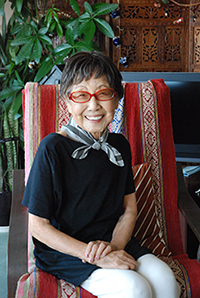 |
|
|
|
Tsuneko Sasamoto; photo © Lucy Birmingham
|
When asked what she thinks of turning 100 years old this month and being Japan's celebrated first female photojournalist, Tsuneko Sasamoto replies with a quick, honest answer, punctuated with a laugh: "I can't believe I've lived this long, and still photographing!" She then adds quietly, "There was a time I didn't want to go on living."
The remarkable centenarian is living life to the fullest, managing a busy schedule of interview requests, TV and radio appearances, book signings, and a string of exhibitions. She is now captivating audiences worldwide with her black and white photo portraiture and photojournalism work, shot over seven decades.
In fact, Sasamoto has only "come out" into the limelight since her mid-nineties, when she quietly revealed her age to friends working in publishing. "People in Japan are so obsessed with age," she says. "When I was 70 I didn't want people to tell me I was too old to be a photographer. So I just kept my age a secret." It was the mechanism that allowed her to continue, says Kate Klippensteen, her friend and international representative. "She's still healthy and her memory is sharp, but the media attention has been overwhelming for her at times."
|
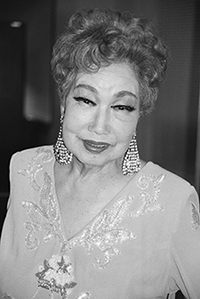 |
|
|
|
Noriko Awaya (1907-99); courtesy of JCII Photo Gallery
|
Sasamoto has photographed a myriad of historical moments and a plethora of personalities, both great and little known. Her subjects have included General Douglas MacArthur and his wife Jean in 1947 during the U.S. Occupation; the Imperial Family; Hitler Youth visiting Japan; and famed Japanese novelists, poets and artists. Among politicians, her 1955 portrait of Socialist Party head Inejiro Asanuma was the last of him alive. He was assassinated the next day.
Much of her work has focused on women and unsung heroines of the Meiji (1868-1912) and early Showa (1926-89) eras. Her exhibition 100 Women at the JCII Photo Salon in Tokyo celebrates their strength and accomplishments in the face of unrelenting gender discrimination. "These were independent, strong women who broke all the molds," she explains. "Women in the Meiji era were so oppressed. Japan was far behind the West in terms of gender rights until World War Two. Nowadays there's so much freedom, but women aren't taking advantage of it."
Among the 100 portraits, some of her favorites include Noriko Awaya (1907-99), a well-known chanteuse and popular music singer, dubbed the "Queen of Blues." "I photographed her toward the end of her life when she was in her eighties and bedridden," says Sasamoto. "I was one of the few allowed to see her at that time, I think because I was born in the Taisho era (1912-26) and she felt I could understand her." Sasamoto remembers the songstress as a symbol of strength and inspiration for many women. "She kept telling me, though, ‘I am not formidable.'"
 |
|
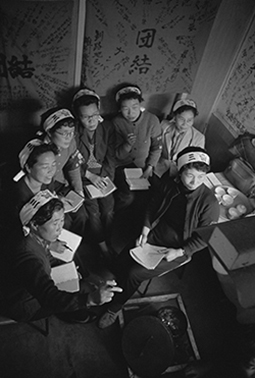 |
|
|
|
| Michiko Yuki; courtesy of JCII Photo Gallery |
|
A group of wives of union workers on strike against the Mitsui Miike Coal Mine (1960); courtesy of JCII Photo Gallery
|
Sasamoto remembers well her photography session with Michiko Yuki, a nursery school director and prominent waka poet. "She was 99 when I photographed her, the same age I am now. Her vision was vast, and her poetry was deeply philosophical. It touched the cosmos."
Another of Sasamoto's favorites is her 1960 photo of a group of wives of union workers embroiled in a strike against the Mitsui Miike Coal Mine, once the largest coal mine in Japan. "I was so impressed with the women's solidarity and their loyalty to their husbands," says Sasamoto. She had read about the strike in the newspapers and was captivated by the women's strength. "They were part of the political demonstrations being mounted at the time. I had never been around people like that before."
Sasamoto often discovered her female subjects in newspaper stories, touched by something important they were doing for society. The work was usually not an assignment, and was funded largely with her own money. She has carried this curiosity, sense of social justice, and independence throughout her life, often inspired by the women she has met along the way.
"When I was young I was often told, ‘You're just a woman, how could you even think of becoming a photographer?' But when I saw Margaret Bourke-White's photography I knew I could be like her one day," says Sasamoto. As a living historical figure and Japan's first woman photojournalist she is now, indeed, the one who inspires.
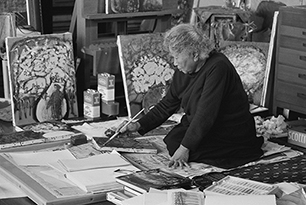 |
|
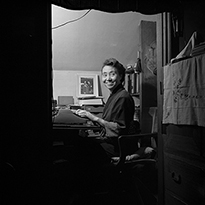 |
|
|
|
| Setsuko Migishi; courtesy of JCII Photo Salon |
|
Shizue Kato; courtesy of JCII Photo Salon
|
 |
 |
Lucy Birmingham
Lucy Birmingham is a long-time, Tokyo-based journalist, scriptwriter, author, and former photojournalist. She currently serves as president of the Foreign Correspondents' Club of Japan. Her articles have appeared in many publications and websites, including TIME,Wall Street Journal, Newsweek, Bloomberg News, and Architectural Digest. As an arts and culture writer her articles have appeared in publications including Artinfo.com, Artforum.com, andARTnews. She is also a scriptwriter and narrator for NHK (Japan's public broadcaster) and has published several books including Strong in the Rain: Surviving Japan's Earthquake, Tsunami, and Fukushima Nuclear Disaster.
lucybirmingham.com |
|
 |
|
|
 |
|
 |
|